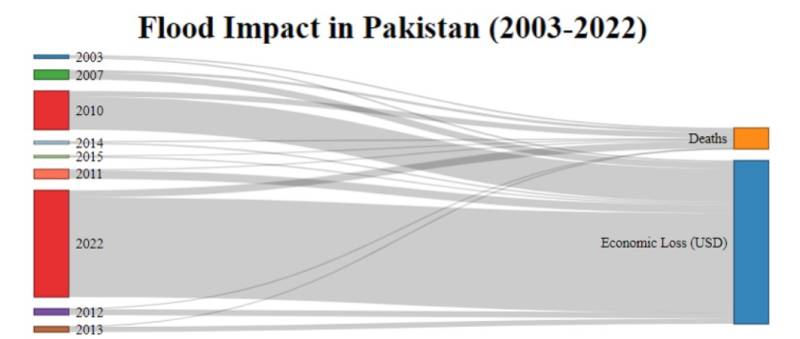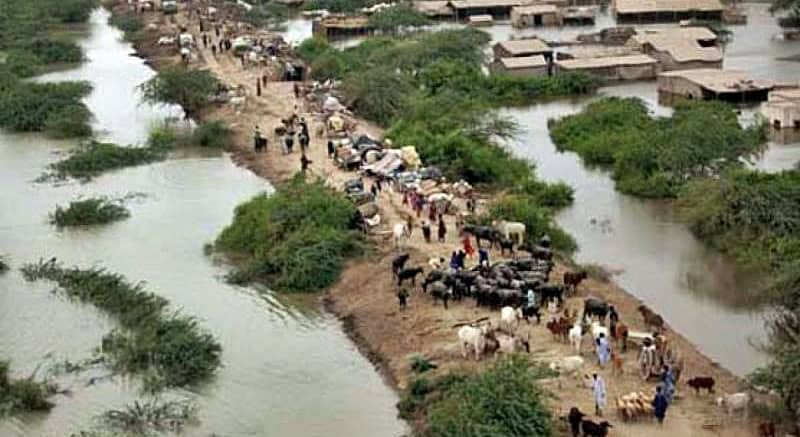Floods, often perceived as natural disasters, have repeatedly devastated communities, economies, and ecosystems. In Pakistan, floods are a recurring and severe phenomenon, frequently resulting in substantial loss of life, displacement of people, and extensive damage to infrastructure. The country’s geographical features and climatic conditions make it particularly susceptible to flooding, a situation further exacerbated by the impacts of climate change.
Each year, monsoon rains and glacial melt combine to create powerful torrents that sweep through the nation’s landscape, causing immediate and severe damage. Homes, crops, and livestock are often washed away, transportation and communication networks are disrupted, economic activities come to a halt, and health risks from waterborne diseases rise sharply. In the aftermath, substantial resources are required for recovery and rebuilding, placing an enormous strain on both national and local budgets. Pakistan has experienced several catastrophic floods, each leaving a significant economic and social impact as shown in the following figure.

Source (FFC, NDMA)
Here is the graph depicting the loss of lives (deaths) and economic losses (USD) due to floods in Pakistan from 2003 to 2022. The Orange box shows the number of deaths, while the blue box indicates the economic losses (in million USD) for each of the respective years. This visual representation helps illustrate the significant impact of floods on Pakistan over the years, highlighting the urgent need for effective flood management strategies and economic adaptation measures. These recurring floods underscore the urgent need for effective flood management strategies to mitigate their devastating impacts and explore ways to convert them into economic opportunities.
Provincial Vulnerabilities and Economic Opportunities
Khyber Pakhtunkhwa, with its mountainous terrain, is prone to flash floods and glacial lake outburst floods (GLOFs). The rapid runoff from heavy rains and melting glaciers can lead to sudden and severe flooding. Historically, KP has borne significant losses, particularly in the northern regions where infrastructure is less resilient. To mitigate these risks, KP can invest in constructing small dams and reservoirs to manage water flow and store floodwater for irrigation during dry periods. Examples from Nepal, where community-led watershed management projects have successfully reduced the impact of flash floods, can be adapted. Additionally, promoting sustainable tourism in safer areas can diversify the local economy and provide an economic cushion during flood events.
Punjab, the agricultural heartland of Pakistan, is vulnerable to riverine floods from the Indus and its tributaries. The extensive canal network can be both a boon and a bane during flood seasons. Historically, Punjab has faced massive agricultural losses, which have ripple effects on the national economy. Agricultural adaptations, such as planting flood-resistant crop varieties and adopting flood-adapted farming
practices, can help mitigate these losses. Learning from the Mississippi River Basin in the United States, where floodplains are managed to support both agriculture and flood control, Punjab can integrate similar practices. Developing aquaculture in flooded areas can also provide alternative income sources.
Sustainable urban planning, including the creation of green spaces and improved drainage systems, can reduce urban flood risks in cities like Lahore.
Balochistan faces the unique challenge of hill torrents, which can cause sudden and intense flooding in the arid landscape. Historically, Balochistan has suffered from both flash floods and droughts, severely affecting its agricultural productivity. Constructing check dams and reservoirs to harness floodwaters for
irrigation can significantly enhance agricultural productivity. Techniques used in Israel’s Negev Desert, such as runoff farming and micro-catchment systems, can be implemented in Balochistan to maximize water use efficiency. Introducing modern irrigation techniques, such as drip and sprinkler systems, can optimize water usage. Reforestation and soil stabilization efforts in the catchment areas can help manage runoff and reduce erosion.
Sindh, being downstream, is particularly susceptible to flooding from the Indus River and heavy monsoon rains. The region’s low-lying areas and coastal zones are at high risk. Historically, Sindh has faced the brunt of major floods, leading to significant displacement and economic losses, especially in agriculture and infrastructure. Investing in flood barriers and improved drainage systems is crucial to protect urban centers like Karachi and Hyderabad. Learning from the Netherlands, Sindh can implement comprehensive floodplain management strategies that include flood barriers, controlled flooding zones, and robust urban planning. Developing specialized insurance products can provide financial security to residents and
businesses. Promoting aquaculture and fisheries in flood-prone areas can turn a natural disaster into a profitable venture. Ecotourism, leveraging the unique landscapes created by seasonal floods, can also boost the local economy.
Strategies for Transforming Floods into Economic Opportunities
Investing in flood-resilient infrastructure across Pakistan can significantly boost the economy. Building flood barriers, improving drainage systems, and constructing flood-resistant buildings are essential steps. Such projects create jobs and stimulate local economies by requiring significant labor and materials. For example, the Netherlands has turned its flooding challenges into economic opportunities through advanced water management techniques like the Delta Works and Room for the River, which have not only protected the country from floods but also boosted tourism and created jobs in engineering and construction. Pakistan can adopt similar strategies to protect and enhance its flood-prone regions.
Integrating flood risk management into urban planning can lead to the development of green spaces and parks that absorb excess water. These areas can also serve recreational purposes, attracting tourists and boosting local businesses. Cities like Karachi and Lahore could benefit from such sustainable urban planning initiatives. Bangladesh, for instance, has implemented floating gardens in flood-prone areas, allowing farmers to grow crops even during floods. This innovative agricultural practice has improved food security and provided a reliable source of income for many families. Pakistani farmers can benefit from similar agricultural innovations, particularly in the flood-prone areas of Sindh and Punjab.
Flooded areas can be utilized for aquaculture, which can be a significant source of income. Developing fish farms in areas prone to flooding can turn a natural disaster into a profitable venture. The Indus River basin, prone to seasonal floods, offers great potential for aquaculture development. Thailand has promoted aquaculture in flood-prone regions, turning these areas into productive fish farms. This has helped diversify income sources for local communities and enhance economic resilience. Pakistan’s Indus River basin, with its frequent floods, is an ideal candidate for developing aquaculture projects. Furthermore, floodplains can be ideal locations for renewable energy projects such as hydroelectric power, providing a sustainable source of energy and creating economic opportunities. Pakistan’s numerous rivers and water bodies offer immense potential for such projects.
Developing specialized insurance products for flood-prone areas can provide financial security for residents and businesses. This can also create a niche market for insurance companies, stimulating the financial services sector. Micro-insurance schemes could be particularly beneficial for small farmers and rural communities. Providing education and training on flood risk management can create employment opportunities in this field. Skilled professionals can offer services ranging from risk assessment to the implementation of flood mitigation measures. Universities and technical institutes in Pakistan could introduce specialized courses on flood management. Engaging local communities in flood management initiatives can enhance social cohesion and ensure that economic benefits are distributed equitably. Community-led projects, such as the construction of small dams and water reservoirs, can be more sustainable and effective in the long term.
Hill Torrent Floods: Harnessing a Valuable Asset for Agriculture
Hill torrents, particularly in regions like Balochistan and Khyber Pakhtunkhwa, can be transformed into valuable assets. These torrents can be harnessed to enhance agricultural productivity by constructing small dams and reservoirs to store floodwater. This stored water can be used for irrigation during dry periods, turning a natural challenge into a sustainable resource for agriculture. By implementing contour farming and terracing, which reduces soil erosion and increases water infiltration, farmers can make better use of the water from hill torrents. Additionally, introducing modern irrigation techniques such as drip and sprinkler systems can optimize water usage, ensuring that crops receive adequate moisture without wastage.
In the catchment areas, reforestation and afforestation can help stabilize soil and reduce the speed and volume of runoff, making the flow of hill torrents more manageable. Constructing check dams and retaining walls can further help control the flow of water and prevent erosion. Downstream, developing efficient canal systems and water distribution networks can ensure that stored floodwater is effectively utilized for irrigation. These methods can significantly improve agricultural productivity and provide a stable water supply, benefiting farmers and boosting the local economy. Pakistan can turn the challenge of floods into a source of economic growth and resilience. Embracing flood-resilient infrastructure, sustainable urban planning, agricultural adaptations, and innovative projects can help the country harness the economic potential of its flood-prone areas, transforming adversity into opportunity.
Sources
1. The 2010 Pakistan floods
2. Pakistan’s 2010 floods
3. 2011 Sindh floods
4. 2022 Pakistan floods
5. Flood risk management and economic impact














